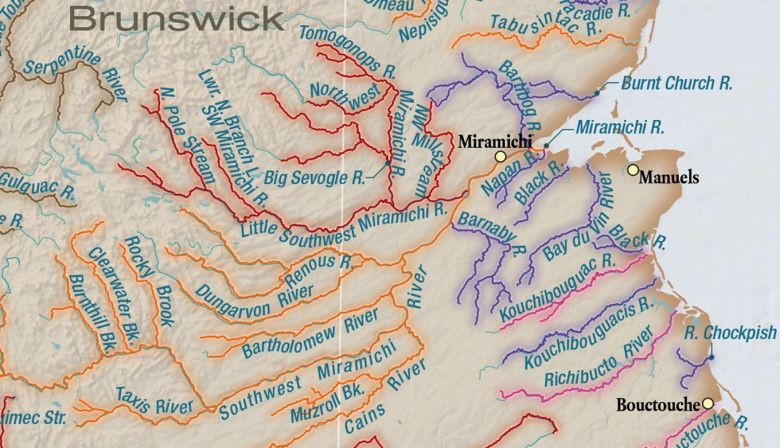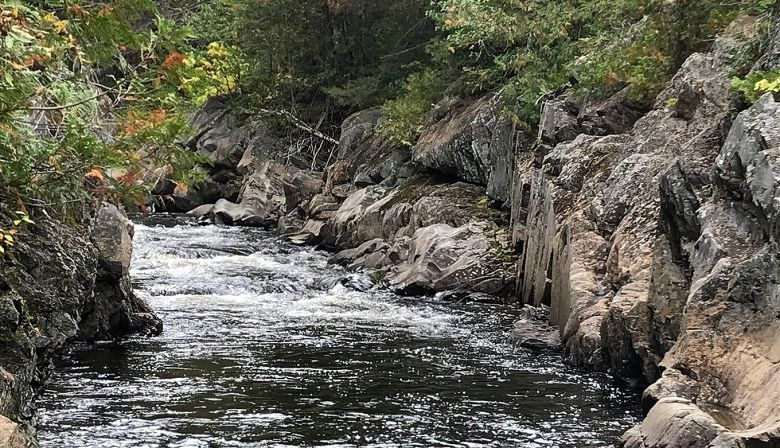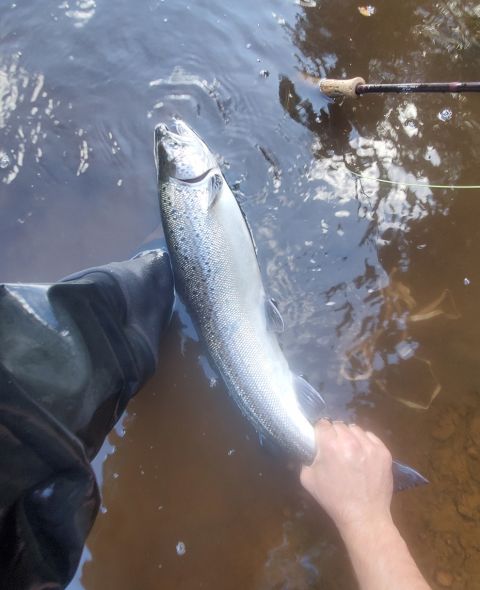
Subscribe & stay up-to-date with ASF


We need to dig deeper and remember the joys that are part of our soul. For many, part of this is the promise of wild rivers and the return of Atlantic salmon. It is hearing the rush of water, and knowing the crisp air, and finding satisfaction that we can outlast the pandemic and find that joy again. And that the joy and satisfaction matters.
Covid-19 makes these months difficult but Atlantic salmon are feeling the urgency of reaching spawning beds, and this year most rivers have a good flow of water that is also cool. That is a celebration, a cause to see continues in the years ahead.
Atlantic salmon can be on people’s minds, even amidst the great struggles, whether conflict or pandemic. If you haven’t looked at Lee Wulff’s accounts in the Atlantic Salmon Journal of General George C. Marshall and Hap Arnold stopping to spend time on salmon rivers in Newfoundland, you should read it. Click here
In the middle of WW2, the twists of life and history were even more uncertain than our present Covid-19 pandemic. But the deeper celebrations of life and joy were just as important.
Time and effort devoted to Atlantic salmon and their rivers is part of a thanksgiving of all we hold dear.
As the season has ended in some jurisdictions, and is winding down in all others, with counting fences no longer in service, the reports are more limited this week.
One excellent piece of news from Greenland. The ASF researchers were able to place the last two satellite transmitter tags on Atlantic salmon to follow their overwintering and home migrations, making a total of 70 for the year. This is an amazing number, as noted by ASF Biologist Graham Chafe.


As the season winds down, there are certainly still some things to be observed on salmon rivers. Perhaps a fly floated across a stream gets clogged by leaves, but at least those leaves are beautiful to see, with their reds and oranges. And there are salmon.

Miramichi
Paul Elson notes,
The Northwest Miramichi system is extremely slow.
The Renous is slow as well, but we are picking up a fish here and there. Water levels are decent everywhere.
Still no “run” anywhere that i have seen.
We have been jumping around from river to river and pool to pool looking for fish. We managed to find some on Sunday on the Cains and had some pretty good fishing. Four of us hooked 8 fish in the afternoon, at the right place and right time i guess.

We are having quite a week here on the Miramichi.
The weather couldn’t be better. Colours are changing every day.
River levels are dropping and the tributaries are producing a few salmon. We are also hearing comments at the tackle shop that there may be a few Fall Salmon moving upriver.
Most of our early salmon have moved into the upper parts of our rivers during the high water levels. The forecast looks good and as conditions improve we should be hearing of more salmon taken on the fly.

Miramichi Counting Fences and Trap Nets to Sept. 30
The Northwest Miramichi Barrier has had 98 large salmon and 118 grilse, compared with last year’s 131 large salmon and 116 grilse
The Northwest Miramichi’s Cassilis Trapnet had 152 large salmon and 354 grilse, compared with 85 large salmon and 53 grilse in 2020.
The Dungarvon Barrier had 126 large salmon and 102 grilse this year, compared with 70 large salmon and 88 grilse last year.
The Millerton Trapnet on the Southwest Miramichi had 281 large salmon and 900 grilse to Sept. 30, compared with 35 large salmon and 40 grilse in 2020.
St. John River
The Mactaquac facility had 60 large salmon and 214 grilse to Sept. 30, compared with 136 large salmon and 334 grilse in 2020. A reminder that the 1998 to 2002 five-year average was 892 large salmon and 2,822 grilse
Nashwaak
Had 22 large salmon and 85 grilse compared with the 2019’s 41 large salmon and 118 grilse.

The Jacquet River Barrier had 80 large salmon and 57 grilse to Sept. 26, compared with 18 large salmon and 25 grilse in 2020.
Sackville River
There were 3 large salmon and 43 grilse this year, vs. no large salmon and 4 grilse in 2020
LaHave
There were 13 large salmon and 162 grilse this year vs. 2019 numbers of 11 large salmon and 142 grilse

Patrick Poirier writes,
Water levels are stable, but more rain would be good. The main run of fall fish has not yet moved into the system. There are still some being hooked, throughout the river.
There are reports of multiple fish on the Baddeck, but waters have quickly receded.
No reports of salmon on the Middle River, as of yet.


Things continue to remain quiet as we wait for the main fall run to arrive. To the best of my knowledge there was a single grilse taken on the Morell in the past 12 days. I don’t know anyone fishing the Mill River in western PEI so I can’t comment there. Water levels remain relatively stable, only dropping by a minute amount each day. They aren’t great but they certainly aren’t dead low either. With no rain in the long range forecast it might make for some tough slugging as we enter into the final three weeks of the season.

Taylor Main continues:
The fall colours are really starting to show now. We have had frost the last couple of mornings and despite some warm daytime highs all waters are now quite cool.


Échos des rivières au Québec
Charles Cusson, Directeur des programmes au Québec :
Le 30 septembre dernier a marqué la fin de la saison 2021. Une saison d’extrême, situation d’étiage prolonger à partir de la 3e semaine de juin jusqu’à la fin du mois d’août. Une saison où le succès de pêche n’a pas reflété le niveau d’abondance apparent dans certaines rivières. En règle générale, la plupart des rivières ont signalé une baisse d’abondance des grands saumons, une hausse importante au niveau des madeleineaux ainsi qu’un achalandage de pêcheurs accru.
Pour l’instant, les débits sont encore un peu élevés et auront l’effet de retarder les décomptes de fin de saison.
Les données de 2021 dans ce compte rendu sont de nature préliminaire en attendant la publication du bilan saumon 2021 par le MFFP (ministère des Forêts, de la Faune et des Parcs) qui sera disponible en février ou mars 2022. Les données des années (2017-2020) proviennent des bilans saumon publiés annuellement par le MFFP.
En terminant, je remercie les saumoniers qui ont voulu partager leurs expériences de pêche par le biais des photos de leurs saumons remis à l’eau et les rivières qu’ils et elles ont visités. Vous avez contribué de façon importante au succès de notre blogue.
Au plaisir de se rencontrer le long d’une rivière en 2022.









Charles Cusson, Quebec Program Director writes :
The season ended on Thursday Sept 30. Mother Nature brought more rain to the Gaspé and Lower St-Lawrence regions during the last days of the season which should help maintain levels into the spawning periods.
It’s been a season where angling success did not reflect the number of salmon present in the rivers.
River managers have reported less abundance of large salmon and a healthy increase in the number of grilse as well as an uptick in the number of rod days sold.
For the time being, end of season in-river counts will be delayed due to higher waters flows and levels.
The 2021 figures presented today are based on preliminary numbers provided by river managers and comparative (2017-2020) data are sourced from the annual MFFP (Ministry of Forests, Wildlife and Parks) salmon reports. The official data will be available in February or March 2022.
I’d like to thank all anglers who agreed to share their fishing experiences by submitting photos of the fish they released and the rivers they traveled to. Your contributions are a very important factor in making our weekly “River Notes” very successful.
Here’s to meeting along a river in 2022.








This is definitely a time we think of families, and also those crisp autumn-coloured days we love each year. In many places the need to reduce potential transmission of the Covid-19 virus means we have to put off family gatherings, patiently, or impatiently.
I would suggest that if you are not already a subscriber and member, you might wish to get the Atlantic Salmon Journal.
